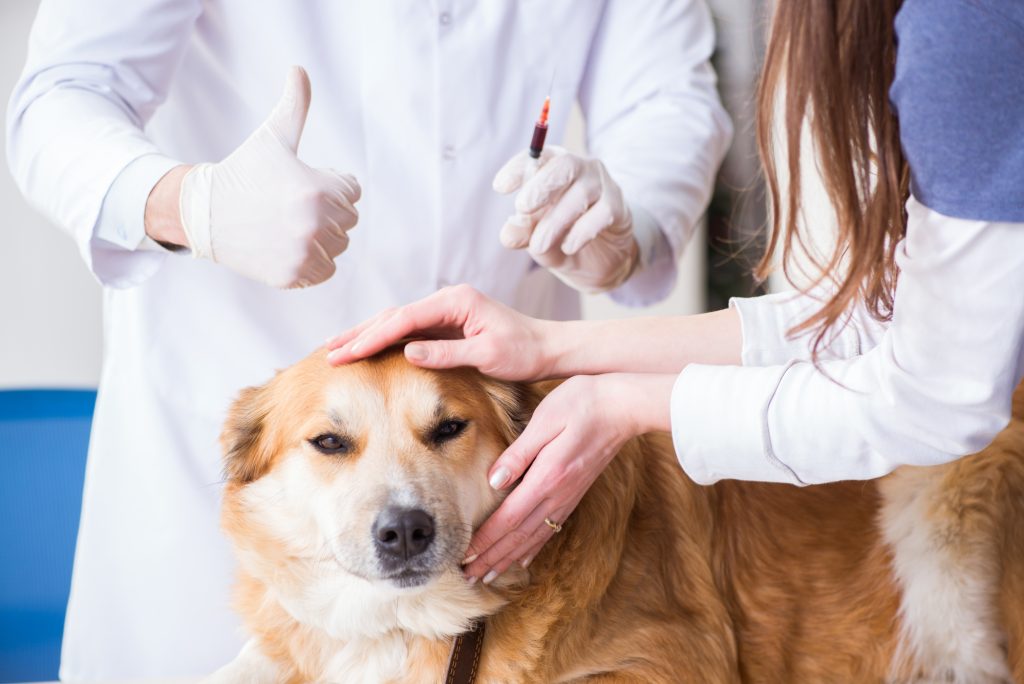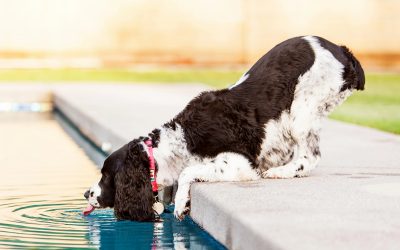Imagine reaching down to give your four-legged friend a pat on the head and noticing a patch of hairless, scaly skin. Itchy round blotches like these are a telling sign of a common canine skin condition: ringworm. Ringworm in dogs is a fungal infection that’s typically spread via contact with an affected animal or object. Though not life-threatening, ringworm infections are highly contagious to animals and humans alike.
The good news is that there are numerous ways to treat ringworm, including topical solutions and oral medications. And with a few strategic steps, you can even prevent the fungal spores from spreading elsewhere. Follow the tips below to bring an infected animal back to healthy skin and high spirits.
Understanding Ringworm in Dogs
Ringworm is a fungal infection that attacks a dog’s skin, hair and nails. Sometimes called dermatophytosis, ringworm actually isn’t caused by worms but by a group of fungi known as dermatophytes. The name “ringworm” comes from the circular patches of itchy rashes often visible on infected animals.
But how do dogs get ringworm in the first place? Dermatophytes’ mold-like fungal spores are most often transmitted through direct contact with infected animals or contaminated objects. In close quarters with an infected dog or human, just one touch of the affected area is enough to spread the condition to your pup. Beach-bound hounds and canine explorers may also encounter ringworm where it lies in the sand or dirt.
Without regular cleaning, ringworm spores can remain dormant on surfaces for up to 18 months. Couches, grooming tools, bedding and toys can all carry an unexpected ringworm infection.
Ringworm in dogs typically comes with several identifiable symptoms. Though the infection can impact any part of your dog’s skin, the paws, face, ears and tail are some of the most commonly affected areas. Symptoms can vary but may include:
- Circular skin lesions
- Red, scaly or bumpy areas of skin
- Patches of hair loss
- Broken hair follicles
- Brittle, easily broken nails
Knowing these signs can help you recognize ringworm as soon as an infection arises. Early detection is vital in preventing the spread of fungal spores before they can reach other pets and humans in your household. Catching ringworm quickly means your dog can start treatment sooner, reducing its discomfort overall.
How Is a Ringworm Infection Diagnosed?
Diagnosing ringworm in dogs starts at home. As a pet parent, you can keep an eye out for the visual symptoms listed above while noting any unusual behavioral changes. For example, if your dog seems to scratch or bite itself excessively, that might suggest something is off. An infected dog may also be more aggressive than usual or show signs of anxiety, such as refusing to eat or withdrawing from others.
If you suspect your dog has an infection, the next step is to consult a veterinarian for confirmation. Certain symptoms, like red and itchy skin, could stem from a different condition, such as canine allergies.
There are a few ways vets can diagnose ringworm, but most will start with an examination of your dog’s body and any visible symptoms. In some cases, patches of hair loss or skin lesions might be enough to identify the condition as ringworm.
Your vet might also suggest using a Wood’s lamp to diagnose a skin infection. Some forms of ringworm will glow bright yellow or green when put under this tool’s ultraviolet light, making detection simple. However, some types of ringworm fungus aren’t visible under a Wood’s lamp, so not all cases can be found using this method.
For greater accuracy, your vet might opt for a fungal culture test instead. After taking a sample of hair and skin cells from your dog, the vet will attempt to grow the fungus in a laboratory. If the spores grow, your dog’s case of ringworm is confirmed. It can take a few days or even weeks to see any growth with this method, which may delay your dog’s diagnosis.
Treatment Options for Ringworm in Dogs
In dogs, ringworm can be treated in several ways. Depending on the case, a combination of topical treatments and oral medication might be needed to eliminate the fungal infection, but it’s important to follow the treatment plan outlined by your dog’s veterinarian.
Ringworm fungus infiltrates your dog’s hair, leaving the follicles brittle and highly contagious. Antifungal shampoo can cleanse your pup’s hair, kill the spores and stop the infection. Instructions may vary for each shampoo, but most require twice-weekly washing until the infection is gone. If you aren’t sure how to choose the right dog shampoo, a veterinarian can likely provide a recommendation.
Antifungal cream is another effective ringworm treatment for dogs that can be applied directly to infected skin. In minor cases with localized symptoms, antifungal cream may be enough to stop the infection’s spread.
Because ringworm is easily transmitted between dogs and humans, it’s important to take care when applying topical medication to your pup. Consider wearing gloves or an apron to protect yourself, and disinfect the space thoroughly after each bath.
More severe ringworm cases call for an oral antifungal drug to fight the infection. Young dogs and dogs with weakened immune systems are more susceptible to the condition and more likely to need stronger treatment. Following all instructions provided by your vet can help prevent the infection’s recurrence.
Ringworm spores can rest atop objects and furniture for months, possibly leading to another infection. For this reason, treating ringworm includes eliminating environmental contamination. Cleaning all bedding, toys and grooming tools used by an infected dog can rid the objects of fungi, and thoroughly disinfecting living spaces can minimize the household’s contact with spores.

Doctor examining golden retriever dog in vet clinic
Preventing the Spread of Ringworm
A single case of ringworm in dogs can put your entire household at risk of infection. Luckily, it’s possible to prevent ringworm from spreading with a few simple steps.
It’s a good idea to isolate an infected animal to reduce its risk of transmission. When done effectively, a quarantine can prevent humans and other pets from contracting ringworm while making the condition easier to manage.
If there’s no space indoors to keep your pup contained, consider looking outdoors. Tools like Halo Collar can construct invisible dog fences, keeping your dog inside a designated area safe from uninfected family members. Just be sure to keep an eye out for signs of dehydration while your pup is outside.
Despite the urge to comfort your pet during this time, minimizing direct contact with ringworm infections is a key part of preventing their spread. Wash your hands thoroughly and avoid touching your skin after touching an infected dog. And while keeping your dog’s spirits up is important, avoid letting your dog lick you until the infection clears. Cleaning the surfaces and floors in your home daily can also reduce transmission.
Keeping up with regular vet checkups can help you detect ringworm in dogs early. Stopping the infection before it’s had a chance to spread far beyond your pup lowers the risk of other household members contracting it. Just as important is continuing your pet’s ringworm treatment for as long as advised by a veterinarian. Ending treatment too soon, even if your dog appears to feel better, can cause the infection to reappear.
Caring for Your Dog During Treatment
For dogs, ringworm can mean weeks of discomfort. Fortunately, there are a few things you can do to help your furry friend during its recovery.
Ringworm lesions can be itchy, leading some dogs to scratch or bite at their broken skin. Giving your pup a soothing bath can relieve some of its irritation and allow the skin to heal. An Elizabethan collar or cone can also prevent scratching in dogs that struggle to resist the urge.
Fighting off a ringworm infection for weeks can take a toll on any dog’s immune system, especially young animals that haven’t had time to build up their defenses. Help your infected pet maintain its strength by feeding it a balanced diet. Healthy foods can give your dog a much-needed immune system boost that may result in a quicker recovery.
Living with ringworm can be a stressful experience for your pet, which can make a full recovery harder to attain. Consider creating a calm environment where your dog can heal in peace. This can mean keeping it supplied with familiar bedding and favorite toys, occupying it with puzzles or turning on some calming music.
While infected dogs should be isolated to prevent further transmission, choosing a place where they can still be near your family can reduce loneliness. At the same time, keeping noise to a minimum can make the spot well-suited to restful healing.
Itch-Free Is the Way to Be! Keep Your Pup Safe and Healthy
Though uncomfortable and highly contagious, ringworm in pets is treatable with the right care. By understanding the signs and symptoms, you’re better equipped to recognize the condition early, before it has a chance to spread to the rest of your family.
If you suspect your dog has ringworm, consult your veterinarian immediately for a diagnosis. Following their professional guidance, you can get your pup on the path to recovery right away. With tools like Halo Collar, you can keep your dog within safe bounds to decrease its risk of another infection in the future.










